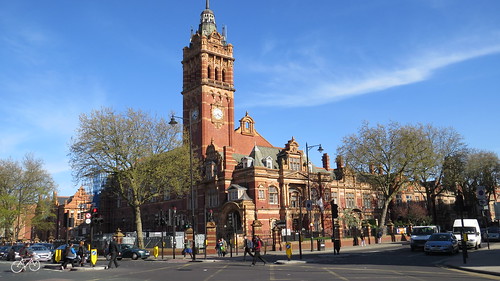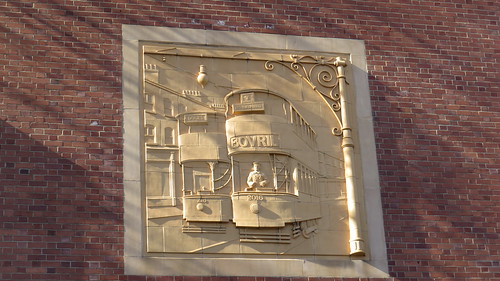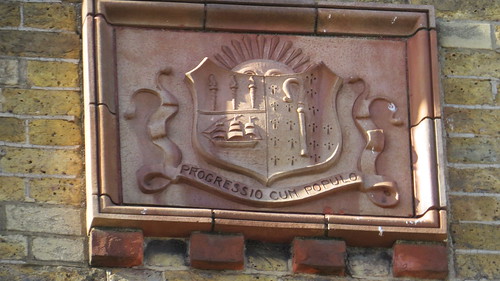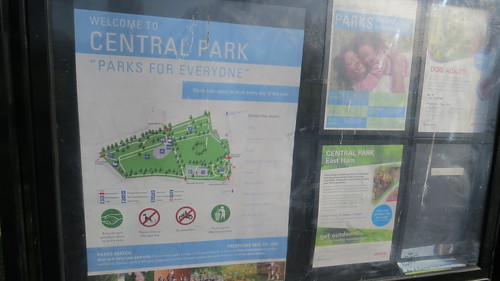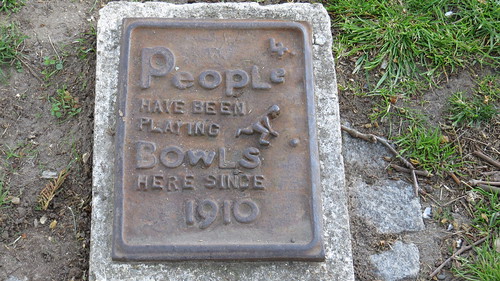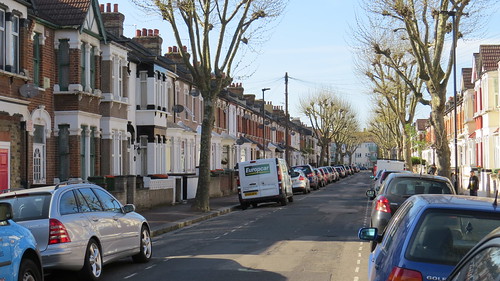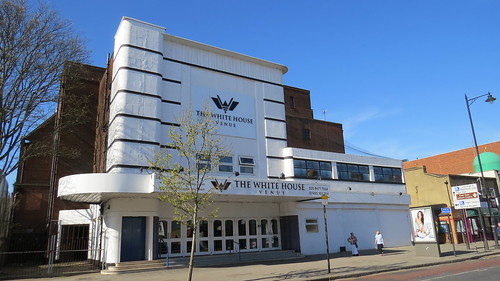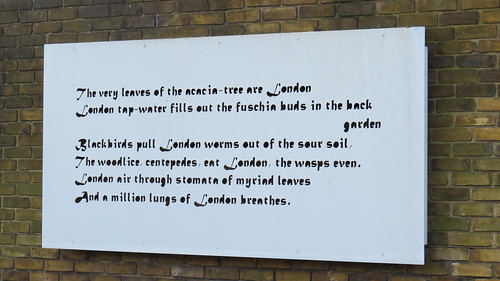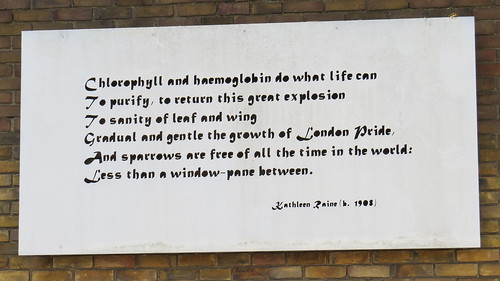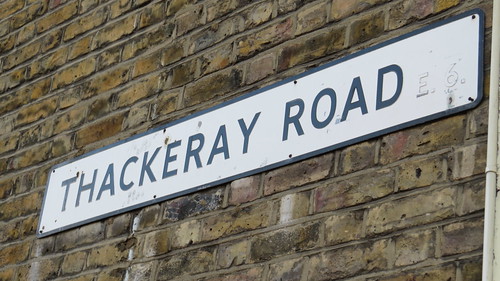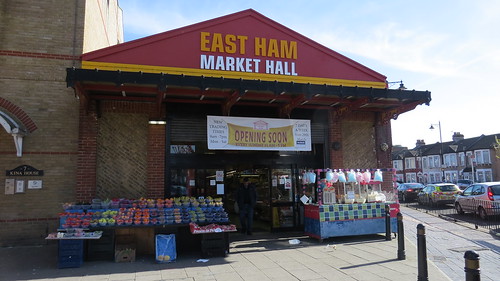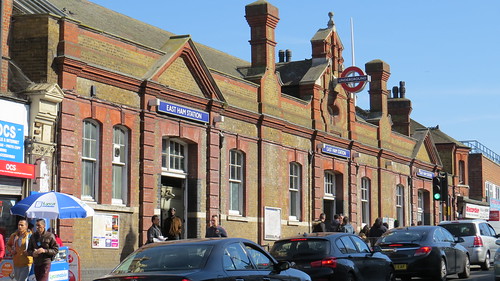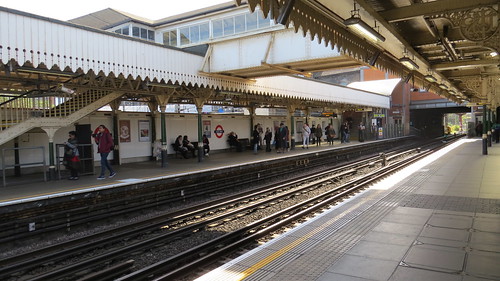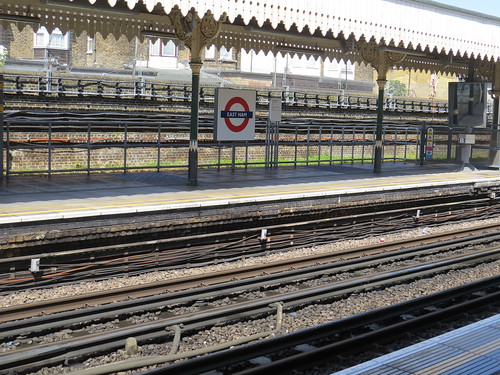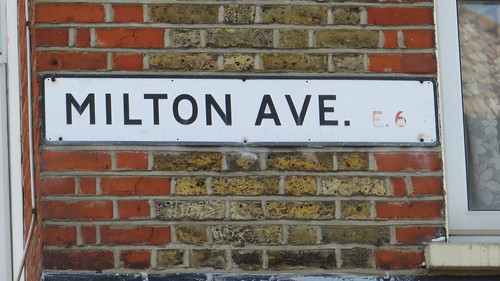E6 is East Ham. This is the most easterly E postcode. (But it is not the furthest east, as we will see when we are get to SE)
We start our walk at East Ham Post Office which is in the W H Smith shop at 125 High Street North. Turn right out of the Post Office and go along High Street North. Our first stop is on the left at the corner of Skeffington Road.
Stop 1: Poundland (Former Woolworth’s store), Numbers 72 – 76 High Street North
This was for more than 50 years until December 2008 a Woolworth’s store. but it was not the original location of Woolworth’s. That was further up High Street North opposite the Palace Theatre, which we will hear about later.
East Ham was bombed severely in the Second World War and the original Woolworth’s store was destroyed in September 1940. They rebuilt here. But this in fact had previously been a department store, so that is why it looks rather grander than the typical suburban Woolworth’s.
Today like many former Woolworth’s stores, it is Poundland.
Keep walking along High Street North. You will reach a cross roads. Our next stop is across the main road on the left.
Stop 2: East Ham Town Hall
Just here is one of the best sets of Edwardian public buildings in London, with the main building being the Town Hall.
East Ham became an Urban District within Essex in 1894. It gained municipal borough status in 1903 and county borough status in 1915. So in the space of 21 years it went from being unincorporated to having the maximum level of local powers. It merged with the neighbouring County Borough of West Ham in 1965 to form the London Borough of Newham.
The Town Hall opened in 1903 and was the borough’s main offices until the council moved to Newham Dockside, E16 in 2009.
But there was not just a Town Hall here. There was also a Library.
Note the Carnegie name. That is because it was built with money donated by Scottish-American businessman and philanthropist Andrew Carnegie. Apparently 2,509 Carnegie libraries were built between 1883 and 1929 across the world, of which 660 were in the United,Kingdom.
And then there was a Fire Station.
Although this now seems to be unused.
But this ambitious municipal development did not stop there. Having followed the buildings along High Street South, now go down the first side street on the left, Nelson Street.
Stop 3: Old Tram Depot
Here we see a clue to what else the Council built here.
This relief must be new as it has a 2016 date on it. But it commemorates the fact that for just over 30 years, this was the location of East Ham Corporation’s Tram depot. And the building is still here with its very obvious doorways for the trams to go in and out.
East Ham Council started operating tram services on 22 June 1901. East Ham had not operated horse trams so it was the first local council in London to have electric trams from the start.
When the London Passenger Transport Board was created in 1933, it inherited the East Ham Corporation Tramway system. But early on it closed this depot, transferring most of the old East Ham trams to other depots in Bow and West Ham with a few being scrapped.
For many years after closure, the tram depot was used by the council for various purposes. In the 1990s the whole site (including the adjacent public baths) was refurbished and converted into East Ham Leisure Centre.
And next door to the depot was a small power station. This was not just to provide power for the trams but also for street lighting. This site still seems to be used in relation to electricity as there is a UK Power Networks sign by the door here.
And you will also see a crest up on the wall here.
This has the motto: Progressio cum Populo (which translates as Progress with the People). Interestingly the London Borough of Newham chose the English version of this motto for the new combined authority. Perhaps West Ham Corporation’s motto (which was Deo Confidemus – We trust in God) was deemed less appropriate for the modern age.
Now return to High Street South and head away from the Municipal Buildings. Our next stop is ahead on the right but to get in you have to go along the side to get to a gate.
Stop 4: Central Park
In the late 19th century, Colonel Ynyr Henry Burges owned much of the land surrounding what is now Central Park. The estate had been built up by his uncle Ynyr Burges, Paymaster of the East India Company, between 1762 and his death in 1792.
The homes surrounding Central Park were built from 1890 to 1910. They were built for office clerks and skilled manual workers. But the Council was far sighted enough to buy up some of the Burges land in 1896 and lay out this park.
The dominant feature at the corner you came in is this rather lovely First World War memorial.
Head into the Park and you will see some little metal plaques in the ground. Like this one, which records that people have been bowling here since 1910.
The Bowls Club however do not so keen on being seen, as their green is largely hidden behind a high hedge.
At this point you do a right turn and head towards what is called Bartle Gate.
On the way you will see another noticeboard which gives a bit more information about the little plaques.
Apparently there are three different trails: one about the history of the park, one about the trees and a third described as a fitness trail.
If you would like to know more about Central Park, here is a link to a fascinating piece from Eastside Community Heritage:
http://www.hidden-histories.org.uk/wordpress/?page_id=204
Go out of Bartle Gate and turn left into Central Park Road. Take the fourth turning on the right – Ladysmith Avenue.
Stop 5: Ladysmith Avenue
Number 38 Ladysmith Avenue was the childhood home of Dame Vera Lynn. She was born a few streets away in Thackeray Road but the family moved to Ladysmith Avenue when she was 4.
She was born 20 March 1917 and was called Vera Margaret Welch. She adopted her grandmother’s maiden name (Lynn) as her stage name when she began performing publicly at the age of seven. Vera Welch would not have sounded quite the same, would it?
She was of course widely known as “The Forces’ Sweetheart” whose recordings and performances were enormously popular during the Second World War. Some of the songs most associated with her are “We’ll Meet Again”, “The White Cliffs of Dover”, “A Nightingale Sang in Berkeley Square”, and “There’ll Always Be an England”.
In 2009, she became the oldest living artist to have a No. 1 on the British album chart. She was 92.
Go down Ladysmith Avenue to the end of the street. Our next stop is straight ahead of you on the main road.
Stop 6: Former Granada Cinema, Number 281 Barking Road
Today this building is called “The White House” and is a banqueting suite.
But it is recognisably an old cinema. This was the Granada East Ham which opened in November 1936.
It was actually on the site of an earlier cinema the East Ham Empire Kinema built in 1914.
Although this spent its entire cinematic life as the Granada it was actually developed by a rival company.
According to Cinema Treasures:
“it was going to be a new cinema for the Denman (London) circuit (part of Gaumont British) who had operated the Empire Kinema, but Granada Theatres were also interested in the site and a deal was struck for them to operate the new cinema which was designed by Gaumont’s house architect William E. Trent and the land was owned by Gaumont for many years.”
The building was only fully acquired by Granada in March 1965.
It closed as a full time cinema in November 1974. After a brief flirtation with the occasional live show and Bollywood films, it was converted into a Granada Bingo Club in January 1976. It remained a bingo hall until November 2014, so curiously it spent around 38 years being used as a cinema and around the same time as a bingo hall.
Now walk along Barking Road as if you had turned left out of Ladysmith Avenue. Our next stop is just on the right.
Stop 7: Stondon Walk
This development was built by the Greater London Council and transferred to Newham in 1986 when the GLC was abolished.
The block was designed with ground floor garages and quite an expanse of brick. No doubt there was a logic to this as it would have minimised the impact of the busy road, but some people thought they had just built it the wrong way round
However it did not look very nice, so Newham commissioned some artwork in the late 1990s.
There is a series of nine stencil relief panels made of steel, and originally painted in pastel colours, which seems to have faded. The first and last of the panels are the text of a poem and the others depict leaves, trees and flowers, showing the seasons of the year chronologically.
The poem was selected from ‘Poems on the Underground’. It sought to complement the ‘natural growth’ and ‘living environment’ themes of the panels. And it so happened that the poet, Kathleen Raine, was born in Ilford, in 1908, which gave a kind of local connection – more info about these panels can be found here at:
http://www.pmsa.org.uk/pmsa-database/3361/#sthash.cD78U5zH.dpuf
And here is the text of the poem:
The Very Leaves of the Acacia-Tree are London
The very leaves of the acacia-tree are London;
London tap-water fills out the fuchsia buds in the back garden,
Blackbirds pull London worms out of the sour soil,
The woodlice, centipedes, eat London, the wasps even.
London air through stomata of myriad leaves
And million lungs of London breathes.
Chlorophyll and haemoglobin do what life can
To purify, to return this great explosion
To sanity of leaf and wing.
Gradual and gentle the growth of London pride,
And sparrows are free of all the time in the world:
Less than a window-pane between.
Kathleen Raine (1908 – 2003)
From Collected Poems 1935-1980, © Kathleen Raine.
Plus here are a couple of the decorative panels
By the way don’t forget to have a look out for Thackeray Road which runs off the other side of Barking Road.
Don’t know where exactly Dame Vera lived in that street. The internet seems curiously silent on the matter.
Now return along Barking Road past the old Granada cinema. Soon on the left you will see a modern road. Go down this and you will see after the bend of the road on your right an entrance to our next stop.
Stop 8: East Ham Market Hall
Go in this entrance and work your way through the market to the other side.
This market hall is privately owned (like the ones we saw in Tooting). The company that owns East Ham Market Hall also owns one in Romford.
This market is around 90 years old according to their website, but it is not any more specific so I don’t know when exactly this was built.
It has a range of stalls – mainly non-food. The owners have obviously spent some money trying to make it look attractive from the outside. Whilst it has a few different specialist stalls, inside it is basically the same old market stuff.
Having reached the other side, you will see a street ahead of you. Go down this and on the left at the corner of High Street North you will see our next stop.
Stop 9 Primark store (site of Gaumont Cinema)
This looks like a new building but notice how it has the style of an old cinema.
There is a reason for this. Part of the facade at least belongs to an old cinema, the Gaumont.
According to the wonderful Cinema Treasures site, it started out in 1912 as the Premier Electric Theatre, In 1921 a new auditorium was erected at the rear and the former Premier Electric Theatre became the foyer and cafe area for the new cinema.
The Premier Super Cinema was taken over by Provincial Cinematograph Theatres who were themselves taken over by Gaumont British in February 1929. It was renamed Gaumont in 1952 and closed down in April 1963.
It was converted into a Bingo Club which lasted to January 2005. It was apparently a remarkable example of an early ‘super’ cinema which had survived virtually unaltered. However it was not listed and so it was lost.
However if you look at the Cinema Treasures website, there are a couple of photos – one when it was a bingo hall and one after it had closed. They show the little tower and how the entrance was to the right of that.
http://cinematreasures.org/theaters/14648
Walk along High Street North. Our next stop is ahead on the right.
Stop 10: Lidl store (Site of Palace Theatre)
This dull looking building is actually on the site of the Palace Theatre of Varieties which opened in December 1906,
Film shows formed part of the variety programme from the early days. In 1933, it became a full time cinema, known as the New Regal Palace Cinema, but with lots of local competition, it reverted back to live variety in December 1935.
The Palace Theatre closed in June 1956 and was demolished in 1958 to make way for a C&A clothing store. In a sign of how the world of retail has changed this is now a Lidl supermarket.
Fascinating fact: Star of the classic soap “Crossroads”, Noele Gordon (1919 – 1985) was born in East Ham (Don’t know where). She was given the middle name of Noele because she was born on Christmas Day. She made her first public appearance at the Palace Theatre but I don’t know when.
As we are here have a look at the side street by Lidl. This is Burges Road.
As we heard at Central Park, the Burges family were local landowners. Most of their estate was south of Barking Road and that is where the main house was. But here is a little reminder that their land went north of Barking Road.
There is also another interesting connection. Burges Road was the birthplace of Herbert Maurice William Weedon (1920 – 2012) better known as Bert Weedon.
He was a popular and influential guitar player in the 1950s and 1960s. He produced best-selling guides to guitar playing and these were apparently a major influence on many well known British musicians, such as Eric Clapton, Brian May, Paul McCartney, George Harrison, John Lennon, Dave Davies, Keith Richards, Pete Townshend and Jimmy Page.
Don’t know exactly where he was born in Burges Road.
Keep walking along High Street North. Our next stop is just on the right.
Stop 11: East Ham station
East Ham station was built by the London, Tilbury and Southend Railway. Their initial line ran from London via Stratford and Forest Gate over what is now the Gospel Oak to Barking line. A more direct line from Bow to Barking was created in 1859 with stations at Bromley, Plaistow and here at East Ham.
The District Railway started serving the station in 1902. The District line was electrified in 1905. A second pair of tracks was added in around 1908 and East Ham station was rebuilt.
In 1936 the Metropolitan line service began serving the station in 1936 and this service (which ran from Hammersmith to Barking via King’s Cross St Pancras) was renamed the Hammersmith & City line in 1988 – though this name had been used as a subsidiary name of this part of the Metropolitan line for some time before that.
Today the station has two operational platforms, served by the District and the Hammersmith and City lines
Much of the original Victorian station architecture has been retained and some restoration work was carried out during 2005.
This station also had platforms on the fast lines. The Fenchurch Street – Southend stopping services were withdrawn in 1962 and the platforms have been partially removed.
In fact the fast tracks are mostly obscured from the working District line platforms by an enamel screen for most of the length of the platform. But you can peek over them by going up some steps. You can just see in the far distance the remains of the steps leading down to the former London bound fast line platform.
There is also a disused bay platform on the northern side of the station by the eastbouind platform.
This connected to the Tottenham and Forest Gate Railway (now the Gospel Oak to Barking line) via a curve. It was closed in 1958.
So this kind of brings us to the end of our E6 walk.
Postscript
However if you carry on beyond the station, you will see the next street on your left is Milton Avenue.
This was the childhood home of 1950s pop legend Lonnie Donnegan. Once again don’t know where exactly, so there is no point in sending you down there.
So that really brings us to the end of our E6 walk. We are at East Ham station (or nearby by if you wandered off to Milton Avenue) for rail transport options. plus of course various buses from outside the station.
In E6, we have seen some impressive municipal buildings, some entertainment sites and some places connected with some well known people who lived in the area. But even with the extensive power of the internet, you cannot always find out where or when a person was connected to an area. So we have had a lot of “Don’t know where” or “Don’t know when”.


